Taekwondo
..................................![]() Overview
Overview
![]() PKG Tours
PKG Tours
![]() Video
Clips
Video
Clips
..................................
![]()
Jeju Championship

¢Ñ What is? | ¢Ñ History | ¢Ñ Philosophy
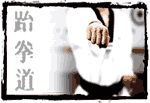 Taekwondo is one of the most
systematic and scientific Korean traditional martial arts, which
teaches more than mere physical fighting skills.
Taekwondo is one of the most
systematic and scientific Korean traditional martial arts, which
teaches more than mere physical fighting skills.
It is a discipline
which shows ways of enhancing our spirit and life through training
our body and mind. It is also a modern sport that has gained an
international reputation, and stands among the official games in
the
Olympics.
Let's take a closer look at the meaning
of the word Taekwondo.
It is composed of three parts as shown
in the English spelling, though it is
one word in Korean.
Tae means "foot," "leg," or "to step on,"
and Kwon means "fist," or "fight." Do
means
the "way" or "discipline." If we put these three
parts together, we can see two important concepts behind Taekwondo.
First, Taekwondo is the
right way of using Tae and Kwon 'fists and feet,' or all the parts
of the body which are represented by fists and feet. Second, Taekwondo
is a way to control or calm down fights and keep the peace. This
concept comes from the meaning of Tae Kwon 'to put fists under control'
(literally 'to step on fists'). Thus the comprehensive meaning of
Taekwondo would be "the right way
of using all parts of
the body to stop fights and help to build a better and more peaceful
world."
With this peace-keeping spirit, Taekwondo
has been developing with the 5000-year long history of Korea, being
called by several different names in the course. In Korea, Taekwondo
was begun as a defense martial art called "Subak" or "Takkyeon,"
and developed as a way of training body and mind
in the ancient
kingdom of Koguryo, under the name of "Sunbae." In the
Shilla period, Taekwondo had become the backbone of Hwarangdo which
aimed at producing leaders of the country.
Taekwondo today is similar to the
martial arts in other Oriental countries and shares some features
with them, because in the course of its evolution it has gained
many different styles that existed in
the martial arts of the
countries surrounding Korea, like Japan and China.
PKG TOURS
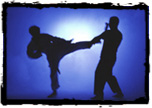 But Taekwondo is very different from many
such oriental martial arts.
But Taekwondo is very different from many
such oriental martial arts.
First, physically it is very dynamic
with active movements, that include a mirage of foot skills. Second,
the principle of physical movements are in simpatico with that of
the mind and life as a whole. Third, it possesses dynamic poses.
From another perspective, Taekwondo can be characterized
by unity: the unity of body, mind, and life, and the unity of the
pose ("poomsae") and confrontation, and cracking down.
When you do Taekwondo, you should make your mind peaceful and synchronize
your mind with your movements, and extend this harmony to your life
and society. This is how in Taekwondo the principle of physical
movements, the principle of mind training, and the principle of
life become one and the same. On the other hand, the right poomsae
lead to the right confrontation, which will eventually produce great
destructive power.
How come we reach such a unity in
Taekwondo? Taekwondo is a way of life, much like having a job, raising
a family, fighting for a cause, or any one of numerous raison d'etre.
What makes Taekwondo different from these is that Taekwondo is an
activity for survival in extremely antagonistic situations.
One must always overcome the enemy that is trying to cause one harm.
But simply winning a fight is not enough to guarantee one's safety,
because the enemy may recuperate and attack again. Moreover, there
may be many other enemies than the one that was just defeated. One
cannot ever
feel safe unless one gains permanent peace. To
attain this permanent or lasting peace, one needs unity. This is
what Taekwondo aims for. Otherwise Taekwon would be no different
from any other street=fighting skills. Taekwondo pursues harmonious
growth and improvements of life through its unique activities. This
is why one could say Taekwondo is a way of life.
To ultimately
enable ourselves to lead more valuable lives, we would do well by
finding the guiding principles deeply hidden in Taekwondo.
Martial art activities organized
as means of national defense. Korean Mandolin bronze swords used.Social
martial arts raised to artistic martial arts with the Jecheon (Heaven
Worship) ceremony. Simple fighting skills combined with dance. Ideas
of a developing Sinseondo (Hermits' Teachings) incorporated into
Taekwondo.
Martial arts for national defense
developed through the power struggles among nations like North Buyeo,
Jolbon Buyeo, East Buyeo, Nakrang, Dongye, Samhwan. Jecheon ceremony
developed: Yeonggo of Buyeo, Mucheon of Dongye, October Festivities
of Samhwan ¢®©¡ lead to the diversification
of martial arts.
a. Koguryeo
The
warrior group `Seonbae' was formed. (Also called as Seonin, Jo'eui
Seonin) An alliance of Jecheon ceremony were organized. Scholarship
and military arts treated on equal terms.
The division of Ssireum
(Korean traditional wrestling) and Taekwondo.
b. Shilla
Pungwoldo reconsolidated and intensified as Hwarangdo.
Sesog Ogye (Five Teachings for Worldly Life) developed. Palgwanhoe
organized as a Jecheon Meeting of folk faiths with military, disciplinary,
and festive functions.
c. Baekje
The warrior group `Saurabi' organized.
a. Gaya
Some of the martial arts skills passed to Japan ¢®©¡
becomes Karate (Originally Kayate, meaning
Gaya's = Kaya's)
Hand, changed into Karate, now meaning Empty Hand).
b. koryo period
The ancient Taekwondo, being acknowledged
as a martial art, developed to Subakheui ('Hand
Striking Skills'),
becomes one of the indispensable skills for warriors. Subak developed
to Obyeong ('Five Soldiers') Subakheui as a type of group competition.
Taekwondo started to develop as a game
or a sport. (as a Subak
Game) A professional model for Subakheui completed. Subag popularized
among citizens.
Subakheui chosen by Byeongjo (the
Department of National Defense) as part of a national exam to select
soldiers. Relative importance of Taekwondo as a national defense
martial art decreased with
the development of weapons like
gunpowder and Jochong ('bird-guns').
Military systems reconsolidated
and general martial arts systematized after the Imjin war (Japanese
invasion in the year of Imjin). Subakheui incorporated into the
martial art system for national defence. (Department of Military
Training in Seoul, and Sogogun in other areas) The section of the
martial arts open in the Gwageo (National Exam for Selecting Government
Officials), encouraging the training of martial arts. The martial
art text book Muye Dobotongji published. Taekwondo secretly handed
down
to people under oppression Japanese colonial rule.
a. Various
names of ancient Taekwondo unified into Taekwondo'.(1965)
b.
Korea Taekwondo Association joined
Korea Athletic Society as a member organization. (1962)
c. Taekwondo designated as a national sport.
(1971)
d. Kukkiwon ("National
Skills Institute") founded. (1972)
e. The World Taekwondo Federation (W. T. F.)
founded. (1973)
f. The 1st World Taekwondo
Championship Games held. (1973)
g. The
World Taekwondo Federation became an acknowledged organization by
I.O.C. (1979)
¢º Philosophical principles of Taekwondo
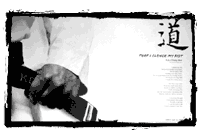 The
philosophy of Taekwondo is very special, but what makes it
The
philosophy of Taekwondo is very special, but what makes it
so special? If we learn philosophy from books, we tend to forget
it
as soon as we leave them, because it is not related to our
actual lives. But since Taekwondo is connected with our lives like
every movement of ours is, we can never forget its philosophy.
That is, Taekwondo
philosophy is one of actions which can be learned from other actions,
and our everyday activities.
Taekwondo philosophy represents
the principles of the changes
and movements in things and human
beings.
It also represents the principles of our lives, since
life consists of
our movements. Therefore, we can say Taekwondo
is a philosophy in itself. We can understand the philosophy of Taekwondo
by doing Taekwondo, and this understanding should lead to better
understanding and enhancement of our life.
The principles of
Taekwondo can be explained in several ways but here we will explain
it simply with the principle of Sam Jae (Three Elements) and that
of Eum (the Negative or Darkness) and Yang (the Positive or the
Brightness). Sam Jae refers to Cheon (the Heaven), Ji (the Earth),
and In (the Man)
and the principles concerning them. In oriental
countries, it has been recognized as the central principle which
explains the changes of everything in the world. Sam Jae and the
changes of Eum
and Yang constitutes the Eight Trigrams for
Divination in the Book of Changes.
The principle of Sam Ja
has been emphasized in oriental countries, especially in Korea.
If you understand Taekwondo, following the principle, you could
understand all the skills and spiritual depth of Taekwondo. The
principle of Eum and Yang has also been emphasized in oriental countries
as the central principle of life. It maintains that everything has
an opposite side.
This principle explains various forms of
changes, but it comes from Taegeuk (the Great Absolute), which represents
the ultimate claim that Eum and Yang were the one and the same thing.
If we understand Taekwondo according to this principle, we will
find a solution, and by continuously changing skills, we will never
get stuck, in any situation. After we understand these philosophical
principles of Taekwondo, we can find proper ways to understand and
develop our lives.
¢ºThe historical development of Taekwondo Philosophy.
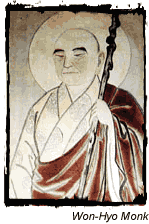 What
is the philosophy of Taekwondo? Taekwondo contains thoughts which
Han (Korean) people had developed through a long history. Its philosophy
is easily explained with Hongik-ingan, Jaese-ihwa, or Hwarangdo
spirit. Hangik-ingan and Jaese-ihwa were not only ideologies of
Tangun Chosun's foundation, but also a fundamental thought of Han
people. With time, these ideas developed into the Hwarangdo spirit
and today Taekwondo's philosophy. Now, let's look at, the principles
contents of the philosophy.
What
is the philosophy of Taekwondo? Taekwondo contains thoughts which
Han (Korean) people had developed through a long history. Its philosophy
is easily explained with Hongik-ingan, Jaese-ihwa, or Hwarangdo
spirit. Hangik-ingan and Jaese-ihwa were not only ideologies of
Tangun Chosun's foundation, but also a fundamental thought of Han
people. With time, these ideas developed into the Hwarangdo spirit
and today Taekwondo's philosophy. Now, let's look at, the principles
contents of the philosophy.
¡Ü Hongik-ingan and Jaese-ihwa
'Hongik-ingan' means a universal
welfare of mankind. It was the idea of the national foundation by
Dangun, and Taekwondo spirit, too has inherited the idea of Hongik-ingan.
It is easily confirmed from the fact that the word of Taekwondo,
itself means to suppress fighting and induce peace. On one hand,
Jaese-ihwa means that the world is educated in accordance with the
reason of heaven. Taekwondo is a principle, not a simple connection
with movements. It is the Korean traditional martial art characterized
by the trinity
of body, mind and life. Thus, the principle
is the reason of all creation,and so it refers to the reason of
heaven in Jaese-ihwa.
Therefore, human beings can be educated
in accordance with the reason of heaven through correct training
of Taekwondo. That's the very meaning of Jaese-ihwa. Hongik-ingan
and Jaese-ihwa appear clearly in the myth of the Korean foundation.
According to it, "In the early age, Hwan-Wung, the son of Heaven
established a nation called Baedal (earliest name of Korea). He
then announced the purpose of the national foundation as Jaese-ihwa
(the world educated in accord with the reason of heaven.) and Hongik-ingan
(an universal welfare of mankind).
¡Ü The Spirit of Hwarangdo
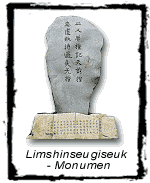
Like this, the idea of Dangun's national
foundation affected various martial
arts ( the old forms of
Taekwondo ) and their groups.
Also, it greatly contributed
to the development of Silla's Hwarangdo. The Hwarangdo spirit was
based on the idea of Sinseondo with the integration
of Confucianism,
Buddhism, and Taoism. It contained the 3 virtues loyality, filial
piety and trust, 5 principles of the world and 3 virtuous conducts
of modesty, frugality and restaint. Now, let's look at the contents
in details.
(
1 ) Loyalty, Filial piety, Trust
- Chung (loyalty)
: It refer to the loyalty
to the nation.
- Hyo (Filial piety) : It means the
filial piety to the parents.
- Shin (Trust) :
It means to have trust among
human beings.
( 2 ) Sye-Sok-Oh-Kye : 5 Principles of the world
- Sa-kun-lee-chung : to follow a nation
and a king with loyalty.
- Sa-chin-lee-hyo : to respect parents
with filial piety.
- Kyo-u-lee-shin : to make friends with trust.
- Lim-cheon-mu-t'wi : not to withdraw
on the battle field.
- Sal-saeng-yu-taek : not to take another
life, unless an unavoidable situation requires it.
( 3 ) Three kinds of beauty (Sam-mi) of Hwarangdo
Three kinds of beauty refer to three virtuous conducts*Modesty : Modesty means the virtue to know courteous refusal. That is, it refers to services done for society without personal interests on gains. Also, it refers to the spirit to contribute to social development rather than that of an individual.
*Frugality : Frugality means not to waste. If we live with the abundant materials without extravagance or waste, we will not suffer if difficult times come around. Also, such frugality generates room to help needy people in society.
*Restraint : Restraint refers to self-denial. It means to win over one's self or ego. Through restraint, people do not fight each other, rather, they live together in harmony.
As mentioned above, the Hwarangdo
spirit is to systematize the thoughts led by Hongik-ingan and Jaese-ihwa
concretely. Thus, Kukiwon said, "Taekwondo spirit was developed
as the tradition and thoughts of Korean people through the old ages.
Then, it was developed as Hwarangdo spirit which made it the spirit
of Shilla's people. Hongik-ingan and Jease-ihwa are the core of
Taekwondo's thought. Before Hwarangdo, they were already systematized
as the traditional thoughts of Han the people, and they developed
into the idea of Sinseondo.
Also, they were called "Poongryudo
" The idea of Sinseondo is the core of Oriental thoughts, simultaneously,
it is a very profound philosophy. Movements embody the spirit physically,
and the
spirit is the inner working of movements. Thus, it
is natural that the thoughts and Taekwondo have developed together.





